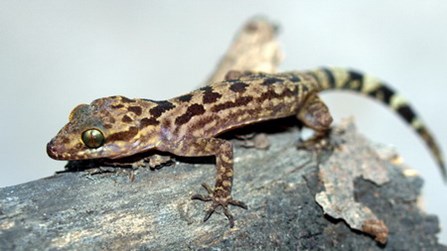
Vietnamese and German researchers have announced the discovery of another lizard species in a small habitat in Tay Ninh Province and a frog with spiny skin in the Central Highlands province of Kon Tum.
Vietnamese and German researchers have announced the discovery of another lizard species in a small habitat in Tay Ninh Province and a frog with spiny skin in the Central Highlands province of Kon Tum.
 |
| The new lizard found on Ba Den mountain near Ho Chi Minh City. |
The lizard was found on Ba Den mountain where two other new species were discovered earlier, Tuoi Tre newspaper reported.
Its body is 78 millimeters long and has dark brown spots on the back and neck.
It is the 32nd lizard species found in Vietnam and has been named “Cyrtodactylus thuongae,” for Dr Nguyen Thi Lien Thuong, a lecturer at the Ho Chi Minh City University of Food Industry, thanks to her contributions to the research into and discovery of amphibious lizards in Vietnam.
She is the only woman member of www.vietnamcreatures.net, a website dedicated to the country's wild flora and fauna.
Phung My Trung, a researcher who manages the website, told Tuoi Tre that the scientists spent more than three years looking for the lizard after they found a dead one to the east of Ba Den.
They had given up hope until they spotted a strange lizard in a stream deep inside a cave at around 600 meters altitude at 2 a.m. one morning in October 2012.
They found another specimen a few weeks later, but it too was a female.
So Trung gathered young people with a love for adventure and organized regular tours to the area for them to both clean garbage and look for a male.
“I believed we would find it sooner or later."
The team found two males, again at around 2 a.m., one day last June.
He said the new species has major differences in appearance and habits from other lizards.
“It is very rare and narrowly distributed in the mountain… It usually only shows up in the early hours; so the reward is for those who are patient,” a smiling Trung said.
Two other species found in the area are Cyrtodactylus badenii and Cyrtodactylus nigrocularis, whose discoveries by Vietnamese and Russian experts were announced in 2006.
Trung said three lizard species living in the same habitat is an interesting discovery, and it might be the only such instance in the world.
As a matter of evolution, the odds are very low of two species sharing such a small habitat -- in this case, caves and cliffs -- let alone three, he said.
“This is great opportunity for scientists to study the evolution or creation of new species.”
But Trung said he is as worried about how to protect the new species as he was excited about finding them.
“Ba Den mountain is being heavily devastated. The [wildlife] habitat is threatened not only by deforestation for agriculture but also by littering by pilgrims and young climbers and, especially, the hunt for them to sell to restaurants.
"Many species face the risk of extinction.”
Meanwhile a group of researchers from the Australian Museum in Sydney have discovered a species of pink and yellow tree frog at a height of around 1,800 meters on Ngoc Linh mountains.
 |
| A pink and yellow frog with spines found on Ngoc Linh mountain in the Central Highlands. |
Gracixalus lumarius, as it has been named, is four or five centimeters long and has pink patches all over its body. Males have tiny spikes on their back and head.
The research team led by Dr Jodi Rowley, an amphibian biologist who explores remote, forested mountains in Southeast Asia, particularly Vietnam, found the frog in flooded tree holes in the mountain.
“Almost every tree hole we looked in had these frogs. They seem to be living only in the tops of mountains in this one area in Vietnam, and this region is known to be home to a bunch of species that are found nowhere else,”National Geographic quoted her Rowley as saying.
The spikes are made of keratin, the same protein that makes up human fingernails and hair and rhinoceros horns.
Rowley said she believes that the spikes, which get bigger during the mating season, help females identify males.
She said on her blog that the frog’s habitat is limited to just a few mountains and the animals is very vulnerable to habitat loss and climate change, which will especially affect the weather in mountains.
“Now that we know the species exists, we hope to ensure its continued survival.”
Rowley's team had discovered a new flying frog named Rhacophorus helenaein 2013 in forests not far from Ho Chi Minh City.
(Source: TNNews)





